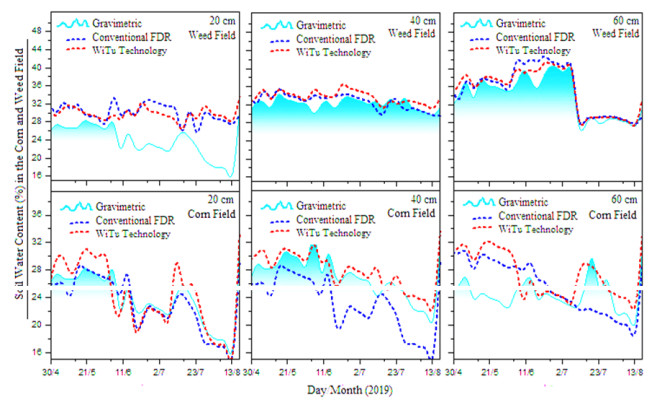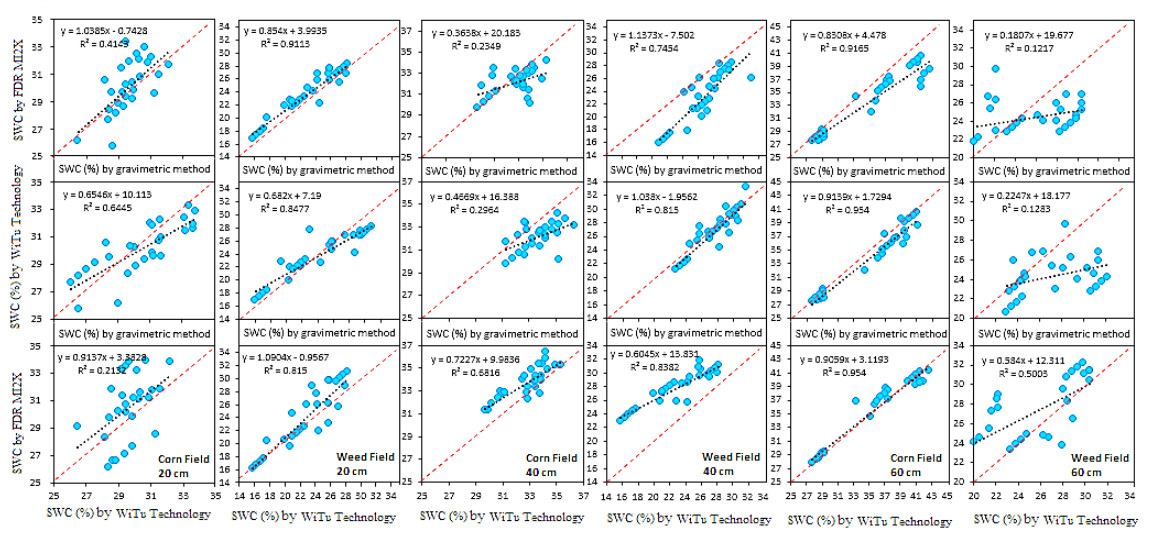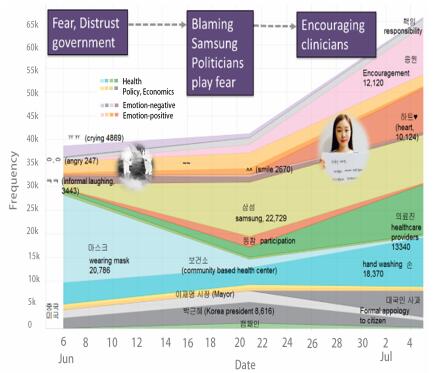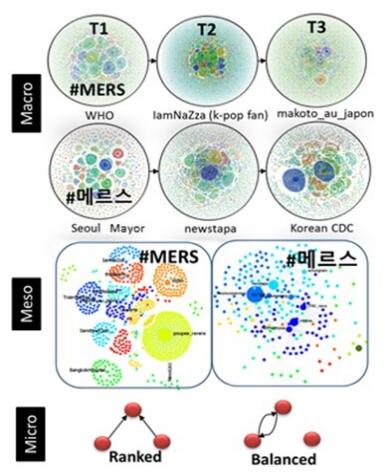1.
Introduction
Accurate determination of soil water content (SWC) is crucially important because soil water is a good nutrient itself, carries essential nutrients for plant growth, critical for photosynthesis and normalizes temperature. The soil water also benefits the microbial communities for their metabolic activities. Soil forming processes and decomposition of crop residues depend on water [1,2].
Typically plant growth is correlated with optimum SWC [3,4]. Both excessive and deficit soil water conditions adversely affect plant life, consequently, reduces crop yield [5]. Generally, to supply the correct amount of water to crop while sustain yield is a primary goal of any agricultural system of the world. Following this objective, commonly sensors are used to determine SWC, since the estimation of soil water based on the traditional gravimetric method is difficult and time-consuming [6,7]. The sensors are faster and easy use to measure soil water storages [8,9]. Specially, Frequency domain reflectometry (FDR) [10,11]. FDR sensors provide continuous observation of the SWC, by transmitting an electromagnetic wave along with probes and records the reflected wave frequency, which presents variations depending on the dielectric properties of the soil measured through the capacitance [12,13]. In such a technique, sensors work as part of a capacitor in which the water molecules are separated and aligned in a dipolar electric field. Structurally the capacitor comprises of two hollow cylindrical metal electrodes settled coaxially but parted by numerous millimeters with a shielding plastic, and the use of an electronic oscillator yields a sinusoidal waveform [14]. This permit the capacitor to interact with the field soil outside of the tube; thus, the capacitance measured could be influenced by the soil bulk electrical permittivity and the dipoles respond to the frequency of the electric field, which can determine the capacitance that leads to knowing the dielectric constant and, therefore, the estimation of SWC. The relationship between the frequency of fluctuation and SWC is inverse [15].
The new layered tubular soil moisture meter (known as WiTu Technology) is developed by Shenyang WiTu Agricultural Technology Corporation limited of China. The basic principle of WiTu is also frequency domain reflectometry. According to the company, the performance of WiTu Technology is stable. The overall index has reached the level of international similar products. The instrument is widely used in soil body profile monitoring to measure the soil water and salt content of various soil types, to rationally arrange irrigation and fertilization, save water resources, and prevent soil surface pollution. The monitoring has continuity, high data precision, easy installation of the instrument, no damage to the soil structure, and free measurement of soil water and salt content at different depths. At present, the equipment has been applied in meteorological, agricultural, hydrological fields in different parts of China, and has been well received by users [16]. The vegetation land cover, chemical transport, water table, temperature, and rainfall intensity are main diverting factors, which affect the state of soil moisture [17] and then effect on working efficiency of sensors [18]. However, still, there is limited research work.
The objective of this study was to statistically evaluate the efficiency of new WiTu Technology and conventional FDR MI2X sensor under changing vegetation land cover.
2.
Materials and methods
2.1. Study site
Experimental site Yuanyang county is located at 34°47ʼN, 113°38ʼE, 70 m above sea level, Zhengzhou, North China Plain (NCP). The climatic condition of the region is temperate monsoon. The average annual precipitation and temperature are about 646 mm and 14.8 ℃, respectively; the frost-free period is 224 days at this site. The soil of the county is predominantly sandy loam. The basic chemical properties of experimental field soil are as follow: pH 8.3, Nitrogen content 0.6 g kg−1, Phosphorus 0.6 g kg−1, potassium 25.4 g kg−1, and organic matter 11 g kg−1 [19]. Furthermore, the location of the experimental site, soil hydraulic properties, and local weather conditions are presented in Table 1 and Figure 1, respectively.
2.2. Details of experimental design
A three replicated randomized completely block design (RCBD) field experiment was conducted during the spring growing seasons from late April to August 2019. Spring corn Nongda-1505 was planted, and a field was left unsown to allow weed to grow freely. The purpose of leaving the field for weeds to estimate sensors performance for deep soil layers, because corn roots generally do not grow deeper [20] as the weed grows[21]. The total amount of irrigation was 90 mm, which was applied to three split doses. There was the same irrigation management for the weed field. The soil water storage change in the corn and weed field was measured every week. The final density of corn was 5–7 plant m2. The root length of the corn crop was 22.3 cm. In the weed field, the grass Chenopodium album L. was dominated during the initial period, covered 70% of the plot and had root length 37.1 cm, Latterly, Humulus scandens (Lour.) Merr largely covered the field up-to 80% which had root length 51.7 cm. Other weeds which were as follow:Eleusineindica (L.) Gaertn, Setariaviridis (L.) Beauv., Abutilon theophrasti Medicus, Conyza Canadensis(L.)Cronq.,
Portulaca oleracea L., and Lotuscorniculatus L. These weeds had root lengths 19.4 cm, 18.2 cm, 56.5 cm, 21.3 cm, 9.4 cm, and 16.5 cm, respectively.
2.3. Methods to determine soil water storage changes
Six WiTu Technology sensors were installed in the middle of each plot. The PVC tubes for FDR sensor measurements were inserted at 30 cm distance from WiTu sensor. While soil samples from the 0–20cm, 20–40cm and 40–60cm depths were taken throughout the crop period using soil sampling auger. Soil sampling was done around the area of the sensor (Figure 2). After recording the weight of wet samples, the soil was oven-dried at 105 ℃ for 24 hours to achieve a constant weight. Then, the soil water storage was calculated using equations (1)–(5) [22]. The soil bulk density (BD) was obtained by dividing the mass of solids in the soil by the total volume [23].
2.4. Statistical evaluation of sensors' performance
The sensors' performance was evaluated by comparing SWC changes measured by sensors with true values of SWC change estimated by the gravimetric method. The following statistical indices were used to determine the sensor's accuracy [4].
Absolute difference (AD%):
Root mean squire error:
Index of agreement:
Correlation coefficient:
Where θr and θs are the real soil water storages measured by Gravimetric and sensor-based methods, respectively.
Absolute difference (AD%) between two real numbers is defined as the distance on the real line between these two points [4]. The closer is the value of the RMSE to 0, the more accurate is the sensor. Agreement index (d) denotes the ratio of the mean square error and the potential error. A perfect match between the gravimetric method and sensor measured results d valueranges close to 1. Zero specifies no fit. While correlations is defined as 0.90–1.00 (very Strong), 0.70–0.90 (strong), 0.50–0.70 (moderate), 0.30–0.50 (weak) and 0.0–0.30 (none).
3.
Results and discussion
3.1. Comparison of soil water storage changes measured by sensors with the gravimetric method
3.1.1. Topsoil layer (0–20 cm)
The FDR sensor measured soil water storages were good agreement with the real observed value of the gravimetric method. The absolute difference (AD) was negative (−1.3–−2.65%) for both corn and weed fields, which indicates that FDR slightly underestimated SWC changes. While WiTu technology overestimated with positive AD (1.40–2.03%). When FDR was compared with WiTu Technology, then AD increased 2.71–4.89%. It means FDR overestimated SWC changes as compared to WiTu Technology. In the case of RMSE, values for both corn and weed fields were low, ranged 1.51–1.31. WiTu Technology had higher RMSE 2.03 only from the weed field. The RMSE was larger between FDR and WiTu Technology with values of 2.23–2.29. The d value of FDR for corn-field showed as 0.74, closer d value 0.90 resulted from the weed field. The d indication of WiTu Technology was well fit. Also, it was fit between FDR and WiTu Technology. Furthermore, FDR had a moderate correlation coefficient for cornfield, the r index showed as 0.64, while it had very strong correlation 95 for the weed field. WiTu Technology had a strong and very strong correlation 0.80 and 0.92 for corn and weed fields, respectively. When compared FDR with WiTu Technology, the r value significantly decreased up-to 0.46 for cornfield, indicated a weak relationship between FDR and WiTu Technology, however, it had strong correlationship coefficient for the weed field.
3.1.2. Middle soil layer (20–40 cm)
In this soil layer, the WiTu Technology measured soil water storage changes that were in good agreement for both corn and weed fields. The range of AD values was between positive 3.35–4.96%, RMSE 1.53–2.00, d value 0.73–0.85 and r 0.54–0.92. The only correlation coefficient of WiTu with the Gravimetric method was decreased in the corn field. In this soil layer the FDR had lower AD 2.24% and RMSE 1.58 in the corn field, and higher AD −14.2% and RMSE 4.29 in the weed field. The accuracy of FDR was highly diminished as compared to WiTu Technology. Also, FDR had a weak correlation with r index below 0.50. When FDR data values were compared with WiTu data, then there was significantly large AD 20.46% and highest RMSE 5.05 in the weed field, however, FDR showed consistency for corn field. The AD and RMSE was not higher. FDR estimated 2.66% higher SWC.The value of the correlation between FDR and WiTu was 0.83, revealed strong correlationship.
3.1.3. Deep soil layer (40–60 cm)
The statistical indices for deep SWC changes were important from the weed field because corn root length does not grow deeper as weed grow. The AD was 4.5% from corn and 5.24% from the weed field than the real SWC measured by the Gravimetric method. The RMSE was increased and ranged 2.20–3.82. While d showed good consistency and r resulted ina weak relationship with 0.35 value, almost near to null correlation between FDR and reference method. In this layer, WiTu sensor showed good agreement with the gravimetric method based on observed SWC changes in the corn field; however; it had higher AD 12.13%, RMSE 4.23 for the weed field. The AD was 6.55% when compared WiTu method. The RMSE ranged as 3.19. The SWC content curves under all methods are shown in Figure 3 and statistical analysis is presented in Table 2.
3.2. The best method for the estimation of soil water content (SWC)
The FDR and new Technology of WiTu showed varied performance as soil depth increased from top layer to deep layer, considering overall results of corn and weed field. FDR efficiency was significantly high at the topsoil layer (0–20 cm) with an average accuracy level of 98.01% and reduced in the middle soil layer up to 91.78%, then increased to 95.13% in the deep soil layer. While the average accuracy of WiTu Technology ranged 98.24%, 95.85% and 92.02% for top, middle and deep soil layers, respectively. These results proved that the soil water detection ability of WiTu Technology was good at the soil depth of 0–40cm, while FDR's ability to detect SWC changes was satisfactory in the top and deep layer and low in the middle layer. Furthermore, the FDR showed good consistency with WiTu in all soil layers of corn field, but there was larger error for the weed field, which indicated a huge difference in the data measured by FDR and WiTu. SWC estimation of FDR and WiTu technology more fluctuated with changing vegetation cover type. These results link with findings of [25] and [26], who reported that the sensor's observations for SWC were varied in the field which was covered by about 30% weeds. Current results are also in-line with [27]; they compared different FDR sensorswith the gravimetric method SWC changes and found that sensors had 1.27–11.90% AD and RMSE 2.16–16.43 under the effect of different soil conditions. Sensors that are often mentionedare their high susceptibility to biotic and abiotic effects [28,29]. In our study, there were two reasons could be attributed to observed data of sensors above 40 cm depth was not well fit with real values, one factor could be maximum soil water storage, sensors may fail to detect SWC precisely when pore spaces of soil are highly saturated [18] and other reason of larger error could be defined as the volumetric effect of bulk density (BD)
[30]. BD directly effect on the sensor results [31,32,33,34]. However, Chow et al. [18] reported that sensors perform very varied with the response to increasing soil depths up to 60 cm. Sensors do not well capture soil water variation patterns with time, and when a rapid change in soil water state takes place after irrigation or rainfall events. In earlier research, Leib et al [35] found that the sensor-based measured SWC significantly varied. Also, many other researchers including reference [36,37,38] and [5], explored the variable performance of sensors with the response to soil depths. Therefore, we should pay attention to the influence of bulk density on the sensor when measuring soil moisture content and correct the measured data.
Therefore, we should pay attention to the influence of temperature and bulk density on the sensor when measuring soil moisture content and correct the measured data in time (Figure 4).
4.
Conclusions
Both FDR and new WiTu Technology showed varied performance as soil depth increased from top to deep layer. FDR efficiency was significantly high at the topsoil layer (0–20 cm) with an average accuracy level of 98.01% and reduced in the middle soil layer to 91.78%, then increased to 95.13% in the deep soil layer. While the average accuracy of WiTu Technology ranged 98.24%, 95.85%, and 92.02% for top, middle, and deep soil layers, respectively. These results proved that the soil water detection ability of WiTu Technology was good at the soil depth of 0–40 cm, while FDR's ability to detect SWC changes was satisfactory in the top to deep layers and low in the middle layer. Furthermore, the FDR showed good consistency with WiTu in all soil layers of the corn field, but there was a larger error for the weed field, which indicated a huge difference in the data measured by FDR and WiTu.
Acknowledgments
The work was supported by the National Key R & D Program of China (2017YFD0301102-5); Zhongyuan Science and Technology Innovation Leadership Project (Project No. 194200510008). We thank Dr. Shah Jahan Leghari (Editor in Chief, J. Flori. and Landscp., UAE) for English language editing.
Conflict of interest
The authors declare no conflict of interest.







 DownLoad:
DownLoad:









